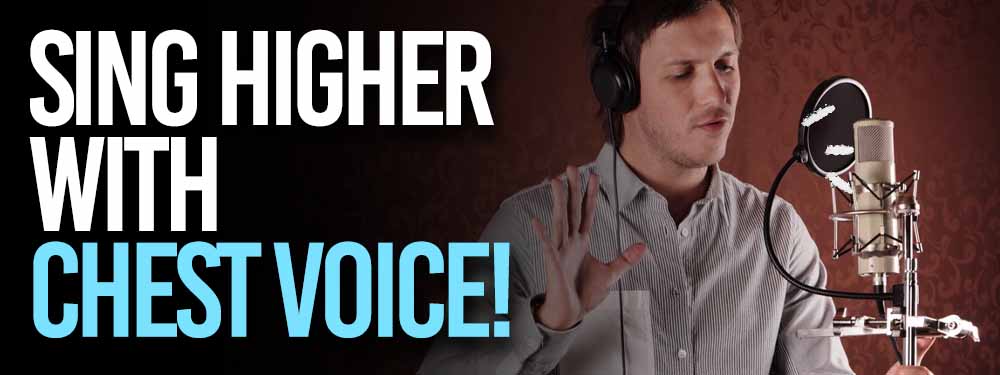
How to use your chest voice when singing: what is it?
Knowing how to use your chest voice when singing can instantly improve your singing.
Most singers have heard about the concept of "chest voice".
But what exactly is the "meaning" of chest voice?
Chest voice is known as the deeper, more expansive part of your voice. To feel your chest voice, place your hand on your chest and you'll feel a vibration when you sing with your normal speaking tonality.
Here are a few indicators that you have a natural chest voice:
-
You squeak when hitting high notes
-
Low notes come out with ease
-
Your voice doesn't come out as it sounds in your head
-
Your voice naturally resonates far in the room
If that's you... Don't sweat it. 😉
You may be nervous, and that's okay! There are many ways to improve your singing and this one.
In this blog, I'll help you identify your voice in different environments, and break down a few ways to improve your singing as a whole.
You can practice with these 30 best practice songs!
First, you need to understand the different types of voices.
Want to get your music on active & relevant playlists that actually get results?
Get your music heard now 👇
Voice types explained:

Have you ever been trying to perfect a specific voice and didn't know where to start?
Whatever the case may be, everyone has probably wondered about their voice at one point or another.
Luckily, it’s a simple matter of identifying your voice type.
Your voice type is simply defined as the type of voice you naturally produce. Different people have different vocal qualities and characteristics, based on their vocal organs.
These qualities are referred to as voice type.
The 3 types of voices are:
-
Chest voice
-
Head voice
-
Mixed voice
The mixed voice doesn't get enough love!
At the end of this blog, you'll have the confidence to sing true to your voice.
Not only that, people will compliment you and notice tour improvements!
Here’s everything you need to know about your voice type and how to identify yours.
Is chest voice your real voice?

A voice type is the type of voice people naturally use in speaking.
It’s often referred to as a speaking voice or an individual’s “natural” speaking voice.
Some people have mixed voice ranges, so this is not 100%.
Vocal folds don't make up your WHOLE vocal range.
Chest is just as important.
Not everybody speaks in a natural chest voice. Some people speak using their heads or mixed voices.
(We'll get to those other types in a minute 😉)
Your voice type is typically determined at a young age, usually around age 4 or 5, and most people can correctly identify their voice type by this age.
Get your own music studio booth (for under $500)

This image above (with the portable music studio) ☝️ is the BEST resource for musicians!
- This little studio booth is ideal for use in tight quarters (dorms, rooms.)
- The soundproof booth is useful for reducing echo and other background disturbances
- The end result is perfectly dry and clear vocals
- You save thousands in studio time and specific equipment

Ever since my producer bought one of these... Life became 100x better.
Just tap here to learn more - this might just be for you!
How to find your vocal range!

There are many myths and misconceptions surrounding vocal type identification.
Most of these stem from the fact that most people are unfamiliar with how to properly analyze their own voices.
Fortunately, there are a few ways you can find out what your voice type is.
3 easy ways to find out your voice type:
-
Ask friends and family
-
Study singers similar to you
-
Hire a vocal coach
The first and easiest method is to simply ask 10 of your friends or family members what their impression of you is.
If you have 10 people close to you who can accurately describe you in one word, you have a good chance of identifying your voice type.
Another method is to find an audio recording of a person with a voice similar to yours.
If you’re lucky enough to be able to find a recording of a person who has a similar voice type to yours, you may be able to find out your voice type.
Example: George Ezra is a natural chest voice. Listen below. 👇
Try recording yourself analyzing your voice and comparing it with the top singers.
(Don't worry - singers of all vocal types find success as artists!)
Once you have analyzed your voice, you can compare it to the voice types listed above to get a better idea of what your voice type is.
How does the chest voice work (physically)
As a result of the increased bass, chest voice is perceived as having a richer quality.
This is also a reflection of how we talk.
Your vocal folds help you to sing your chest voice!
In general, men have a deeper range because of the larger vocal cords that come with adulthood. Women have a higher frequency range due to their narrower vocal folds. Anyone may acquire a chest voice if they have enough airflow.
Look at the image below for a picture demonstration. 👇

( though it may take a significant amount of power and airflow to resonate correctly!)
Do men have a wider chest voice range than women?

Men and women are different in many ways, and voice is one of them.
Each person has a unique set of voice type characteristics, but there are some general characteristics that every voice type shares.
Men are born with a baritone voice due to their tendency to speak with their chests puffed. In general, the sound will be louder and more booming. It can even have a gruff or husky quality to it.
If you're a woman and this sounds like you then no worries!
You still have your mixed voice. Your mixed voice comes much easier than men's.
There are many women with a natural chest voice, Lorde is one of them.
Just listen to her depth of voice below. 👇
male mixed voice range
Let's dive deeper into how the male throat works!
Men are more likely to have a lower singing voice than women are since they have different ranges and hormones, this is why they are different.
G# to E is the average range of a man's voice when he sings.
This makes sense since the male mixed vocal range is known to be higher than women's.
Most women have voices that go from F to E when they sing.
General rule: The lower the note, the easier it is to sing for men.
Just because men have a lower singing voice than women, doesn't mean that they are better.
Many notes that require head and chest voice can't break well in most men (example: falsetto.)
Obviously, not every man can sing, and there are a lot of habits men have which destroy their ability to sound good.
A large majority of men like to drink and smoke, damaging their vocal sound over time.
While this isn't the main reason why men struggle to hit different pitches, it's a factor.
Chest Voice Vs. Head Voice

As the name suggests, the chest voice has a richer, fuller sound than the head voice.
You can have some chest voice even if you’re a head-voiced singer.
If you like to sing in your chest, you might also have a significantly deeper chest voice
What Is the difference?
Deep chest voice is frequently defined as having a “strong” or “full” timbre. The head voice has a brighter and more upfront tone than the chest voice. "Pretty" and "refined" are common descriptors for the sound of a head voice.
You can have some chest voice even if you’re a head-voiced singer.
The head voice is often the most sought form of vocal tone among voice students and vocalists.
The head voice is frequently what all voice teachers seek to achieve for their pupils.
Some people speak with vocal fry, I this is you then you should stop it.
This sympathetic resonance is damaging your singing potential.
Is singing in a head voice bad?
Let's get this straightened out.
There is no "good" or "bad" when it comes to using your vocal range. I don't recommend you go against your biological voice too much, any vocal coach will say the same thing.
The better question should be "Will I sustain this?"
If you think think the answer is no, then there's no harm in switching back (no pun intended.)
The different voice types are designed for anybody to sound good.
Your vocal range is something that you're sadly born with.
Which is easier - chest voice or head voice?
There is no easier or harder.
Some people have more power and a lower register in their voice.
For them, speaking/singing with a chest voice is much easier.
Sure, while chest voice is easier for some, it's the complete opposite for others.
Remember: your body is made a certain way by design!
Not everybody was born with thick vocal cords or rich tones.
If the head voice comes naturally, no need to destroy your vocal cords for another singing voice.
Take pride and joy in your chest and head voice!
Sign chest voice to your heart's content. or let your head voice shine.
Follow how you're designed and you'll have the most singing integrity. 😁
Can singing in falsetto damage your voice?
There is a lot of work that goes into singing in falsetto, and it can be hard.
Generally, the falsetto is a high-pitched, soprano range that goes above your natural head voice. It's often used by singers when they want to sound young, innocent, or angry.
Your vocal cords are less durable than you may think.
It's not that falsetto is a way to make your voice sound like it's coming from a higher part of your body, rather it's a narrowing of the vocal cords.
It's during this frequent narrowing that the strain comes since we're fighting against our natural biological voice.
The risk isn't that you'll lose your voice immediately, but when you eat damaging foods and don't rest then the damage adds up.
Make sure you protect your voice range and take things slowly!
Increase your chest vocal range to sound more "powerful"

As you play more exhausting notes, one of the most important things you can do is keep your diaphragm in touch.
Large muscles in your chest control how loud your voice is. You need to keep a strong connection to your diaphragm even when you are pushing air out of your mouth. This will help you sing better.
A steady and even pressure on your chest means that you don't have to use your respiratory muscles to push air out of your lungs, but you do have to keep that pressure there.
As long as your diaphragm and lungs stay connected, you can push out more air while still maintaining a steady level of air pressure in your lungs.
This will make your sound more full, and it will help you find more high notes.
How to switch from chest voice to head voice

It can take work to go from your chest voice to head voice, but it's very achievable!
To find the "carry-over" between chest and head voice, you can hum or sing quietly in between them.
After you open your mouth, there is a direct link between the volume you can still produce and the actual pitch of your voice!
By humming or keeping your voice quiet, you can carry over a little volume that makes your pitch go up.
Your tone can go from warm to powerful quickly if you create the right habits.
To sound more balanced, try channeling your mixed voice and then adding more power.
This will fundamentally change the way you sing.
Try Singing in a mixed voice range

It is only by combining multiple voices that we can achieve such a wide range of richness, power, and precision!
To achieve the desired effect, you must sing with your "mixed" voice.
The ultimate goal is to develop the way you speak/sing.
Watch videos online and you'll learn the mixed voice in quick succession.
The mixed voice is exactly as it sounds: a merger of chest and head voice.
It is possible to bridge the gap between high and low registers by using mixed vocals. You'll hear a variety of vocal styles here, from high to low.
You'll get the most out of blended voices when the song calls for a lot of strength in the upper notes.
Examining the chest voice and the head voice, the two primary components of a singer's mixing voice might be useful.
When I speak to my vocal coach, they always tell me to develop my ear.
If I can hear the note better, then I'll have an easier time creating it.
Not to mention... Practice all the time! Even in the middle of the day.
How to improve Chest voice
Singing from the chest is the voice register used frequently in a song.
Learning to sing with the chest voice helps improve articulation power range and ability.
It also improves throat breathing! All singers need to master this ability.
Continue reading to learn how to sing from the heart (chest.)
The world is your oyster, take care of your throat and you'll hit the right note!
5 tips to train your chest voice

Let's improve your chest voice!
5 easy ways to improve your chest voice before singing
-
declutter your mind
-
Feel where your chest voice resonates from
-
stand in the right position
-
drink water
-
warm-up your voice
DO these daily to train chest voice!
Your vocal register can take time, though.
If you naturally sing high notes, you don't need to stress yourself by over-using your chest voice.
Take it day by day to train your entire vocal range!
Follow these small & easy techniques for long-term success!
When to sing in chest voice
The most important thing about singing with your chest voice is to be relaxed.
When singing songs written by powerful singers (like Adele) then your chest voice becomes mandatory. Otherwise, you won't have the stamina to power through.
Make sure you're using enough air without making it too hard.
When you project too little air, you are likely to be employing too much power, or strain, in your voice.
This will make your pitch overly high, and can potentially harm your vocal cords.
Remember that you need to maintain a tight connection between your diaphragm and your lungs when you are singing!
Try to avoid pressing too hard with your breathing.
4 Best Chest Voice Exercises

Let's do some chest-voice vocal exercises!
Practice these every day to help us learn how to have a pronounced chest voice.
Once you learn to effectively channel your vocal skills, you can sing in a whole new way.
Chest Voice Exercise #1
Hum lightly while holding a light m pitch.
Begin by humming softly at the recommended pitch for your voice.
Do this for one complete breath.
After that, carefully inhale through your nose before repeating the process.
Chest Voice Exercise #2
Maj 3rds Scale. This is a beautiful small design of 12321.
Work this up and down your range starting again on mild m hum then progressing into vowels starting with ee, oo then ah.
Lip trills and vowel/constant pairings like LooLohLahLehLeeLee can be added to this as well.
Chest Voice Exercise #3
This exercise is all about the vibrations your voice cords make in your body.
This works by making a series of gut-grunting sounds. Sing with your chest voice to feel vibrations in your chest.
When you feel it, hold the grunt, and slowly transition it into an m hum.
How to sing higher in chest voice

You need to change your mindset and think of singing as a skill that can be learned.
Producing chest voice sounds ain't easy.
The more you learn about how your voice works and the basic rules, the easier it will be to get better at singing.
To help you reach higher notes, think about where the note you want to reach on the musical scale and where it is on the scale.
Even if you know how to read music notation, you can look at your phone's keyboard while you're singing if you need help.
Singers often don't use enough breath, which makes their pitch not rise.
Hopefully, now you know how to use your chest voice when singing!
Get your music on playlists now.
It’s time you get your exposure and listeners up - playlisting by Boost Collective has been trusted by 50,000+ artists worldwide.
It’s easy: Search your song, get on playlists, and track your campaign.
What’re you waiting for? Tap in - and get added to playlists in 24 hours.
Join Boost Collective for free here.


